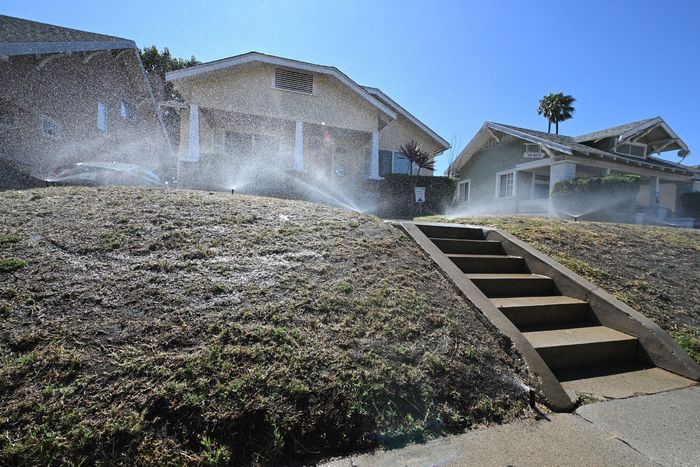
The Colorado River is drying up. This day has been coming since the agreement to divvy up its water was made exactly 100 years ago, signified most strikingly by lengthening white rings of mineral deposits left in wetter years tracing the shores around Lake Mead, the nation’s largest reservoir, now a slowly draining emerald-hued bathtub in the desert. The American Southwest’s worst drought in history has stressed every inch of the river’s 1,450-mile watershed, leaving a system so severely depleted that officials can no longer ignore the scientists who have been sounding the alarm for decades: There is no more water, and there is no more water coming. (At current use rates, the most generous estimates say there are four to six years left.) Staring down forecasts predicting yet another winter of exceptionally low snowpack levels, a consortium of 32 agencies that supply water to 40 million Americans living in both the driest and fastest-growing places in the U.S. have finally made a historic agreement to reduce water use — most significantly by setting a goal to decrease grass lawns throughout their service areas from Denver to Santa Monica by 30 percent.
The move will target “nonfunctional turf grass,” meaning the grass in, say, street medians will be torn out, while parks, sports fields, and golf courses (unfortunately) can stay put. Those extraneous grassy knolls will ideally be replaced by “drought- and climate-resilient landscaping,” including planting more trees, according to the agreement. The language of the nonbinding memorandum of understanding is vague enough that private lawns may escape the kill list (for now). Also untouched by the agreement: 5.5 million acres of agriculture, like alfalfa and cotton, that accounts for 80 percent of the Colorado River’s water allocation and has only grown thirstier over recent decades, fueled by federal subsidies and overseas investment. Overall, this announcement is good news, but still, the most historic agreement ever made in the history of U.S. water conservation won’t be enough to stave off the inevitable shortages that will soon permeate every aspect of daily life. “Every acre-foot of conservation helps,” says Sarah Porter, director of the Kyl Center for Water Policy at Arizona State University, “but even if all of the conservation proposed in the MOU happens, it won’t be sufficient to stabilize the system.”
For the 40 million people across seven states and 30 tribal lands who get their water from the Colorado River, the outlook is bleak. Scientists say usage must be reduced to 9 million acre-feet annually, about 40 percent less than today. Within a decade, households would face strict restrictions on daily water use paired with across-the-board cost-of-living increases, including dramatic increases in energy costs. The Indigenous nations that hold inherent rights to the river would be even more disenfranchised from accessing their water allocations. The impact would ripple far beyond just the service area when considering the corresponding drop in food supply — the Colorado River irrigates 90 percent of the vegetables consumed in the U.S. in winter.
Local municipalities have already taken some strides to avert such a crisis, dramatically reducing their water use in the last two decades “by over a million acre-feet, while also adding over 5 million people to our communities,” as the MOU’s language notes. Cities are nuking ornamental turf on publicly owned or managed land and setting up new restrictions for commercial-property owners, like Las Vegas did last year. There’s also been a marked increase in municipal water recycling, with successful demonstration projects in parched California communities that could help take the pressure off demand upstream. And even though backyards aren’t being targeted for mass-xeriscaping just yet, agencies have been boosting incentives for homeowners in the hopes they’ll do the right thing on their own; for example, L.A.’s Department of Water and Power, which services 681,000 customers and saw its lowest water use on record this summer, just raised its turf-replacement rebate from $3 to $5 per square foot.
Still, comparing a sprinkler chugging across the turf-sown entrance to a suburban neighborhood twice a week with a half-acre of heavily irrigated cotton fields, the agreement’s aspirations sound like a literal drop in the bucket. But it’s not nothing, and the fact that the 30 percent figure was negotiated and agreed upon by nearly three dozen powerful agencies is a significant step in itself, says Sharon Megdal, director of the University of Arizona’s Water Resources Research Center. “Now we can look at this number and say, How did we perform?” Megdal says, although, as she points out, there is no target date set for that assessment yet. While this MOU won’t be enough on its own, perhaps most critically, she says, the agreement communicates the severity of the crisis, helping to signal further cutbacks may be coming sooner than later, and that everyone who relies on the Colorado River needs to modify their expectations for how to incorporate green and grassy spaces (which are still important) into their communities. “These sorts of things are key to raising awareness of the seriousness of the situation,” Megdal says. “We all have to adjust to using less water.”




